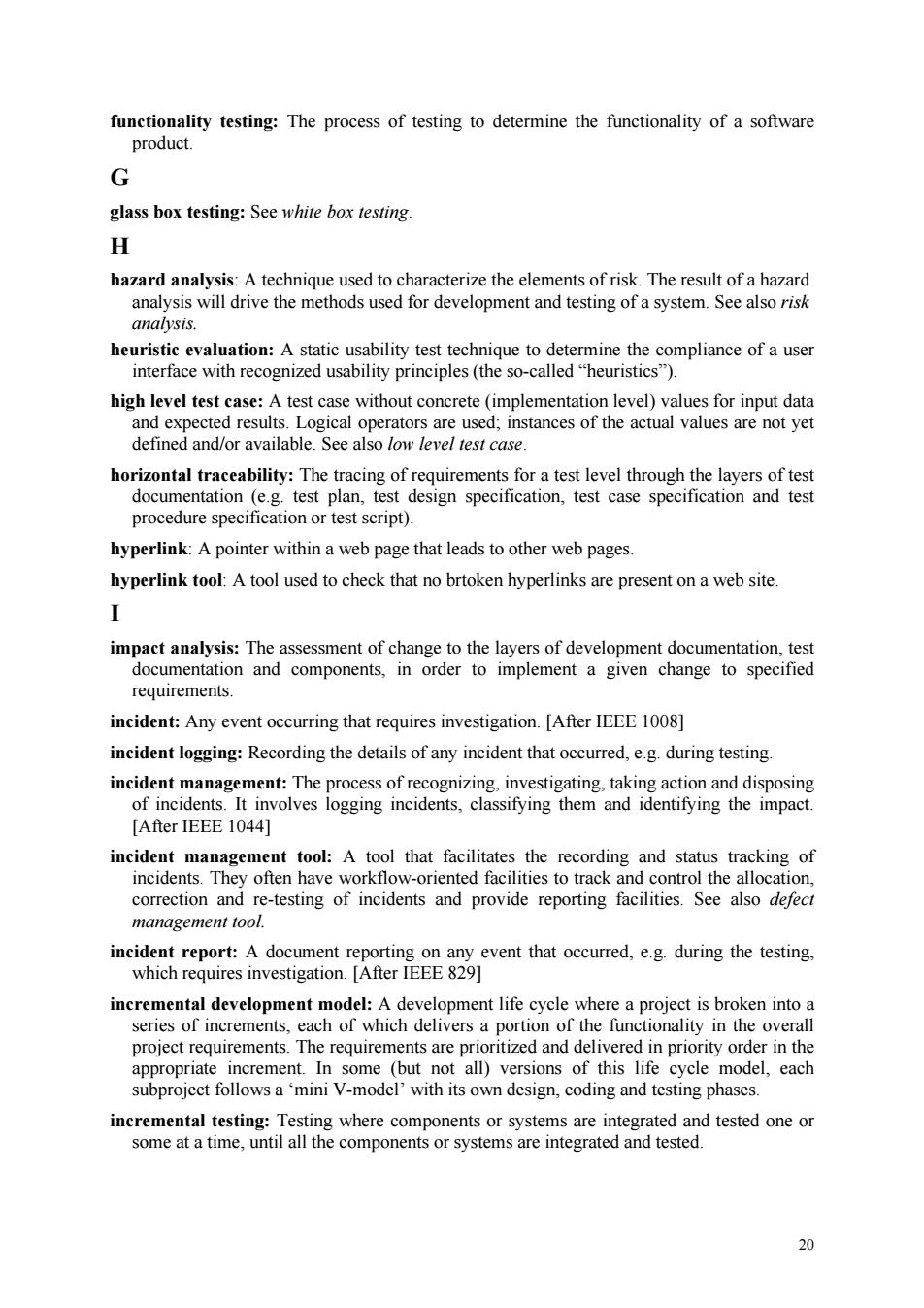正在加载图片...

functionality testing:The process of testing to determine the functionality of a software product. G glass box testing:See white box testing. H hazard analysis:a technique used to characterize the elements of risk.The result of a hazard analysis will drive the methods used for development and testing of a system.See also risk heuristic ty test high level test case:A test case without concrete (implementation level)values for input data and expected results.Logical operators are used;instances of the actual values are not yet defined and/or available.See also low level test case. horizontal traceability:The tracing of requirements for a test level through the layers of test documentation (e.g.test plan,test design specification,test case specification and test procedure specification or test script). hyperlink:A pointer within a web page that leads to other web pages hyperlink tool:A tool used to check that no brtoken hyperlinks are present on a web site nt do ntation and comp op ents,in to the lay rde to implement a enchange ecified requirements. incident:Any event occurring that requires investigation.[After IEEE 1008] ineident logging:Recording the details of any incident that occurred,e.g.during testing. incident ma :The process of recognizing.investig vorves logging incidents. classifying them an incident management tool:A tool that facilitates the recording and status tracking of incidents.They often have workflow-oriented facilities to track and control the allocation. correction and re-testing of incidents and provide reporting facilities.See also defect management tool. ineident report:A document reporting on any event that occurred,e.g.during the testing. which requires investigation.[After IEEE 829] odel ev elopment life cycl nere a proje s brok ken into nts The vers nd deli ollV-modelt isow desinoingnd t ment In me (hut not all)version s of this cycle odel,each incremental testing:Testing where components or systems are integrated and tested one or some at a time,until all the components or systems are integrated and tested.20 functionality testing: The process of testing to determine the functionality of a software product. G glass box testing: See white box testing. H hazard analysis: A technique used to characterize the elements of risk. The result of a hazard analysis will drive the methods used for development and testing of a system. See also risk analysis. heuristic evaluation: A static usability test technique to determine the compliance of a user interface with recognized usability principles (the so-called “heuristics”). high level test case: A test case without concrete (implementation level) values for input data and expected results. Logical operators are used; instances of the actual values are not yet defined and/or available. See also low level test case. horizontal traceability: The tracing of requirements for a test level through the layers of test documentation (e.g. test plan, test design specification, test case specification and test procedure specification or test script). hyperlink: A pointer within a web page that leads to other web pages. hyperlink tool: A tool used to check that no brtoken hyperlinks are present on a web site. I impact analysis: The assessment of change to the layers of development documentation, test documentation and components, in order to implement a given change to specified requirements. incident: Any event occurring that requires investigation. [After IEEE 1008] incident logging: Recording the details of any incident that occurred, e.g. during testing. incident management: The process of recognizing, investigating, taking action and disposing of incidents. It involves logging incidents, classifying them and identifying the impact. [After IEEE 1044] incident management tool: A tool that facilitates the recording and status tracking of incidents. They often have workflow-oriented facilities to track and control the allocation, correction and re-testing of incidents and provide reporting facilities. See also defect management tool. incident report: A document reporting on any event that occurred, e.g. during the testing, which requires investigation. [After IEEE 829] incremental development model: A development life cycle where a project is broken into a series of increments, each of which delivers a portion of the functionality in the overall project requirements. The requirements are prioritized and delivered in priority order in the appropriate increment. In some (but not all) versions of this life cycle model, each subproject follows a ‘mini V-model’ with its own design, coding and testing phases. incremental testing: Testing where components or systems are integrated and tested one or some at a time, until all the components or systems are integrated and tested